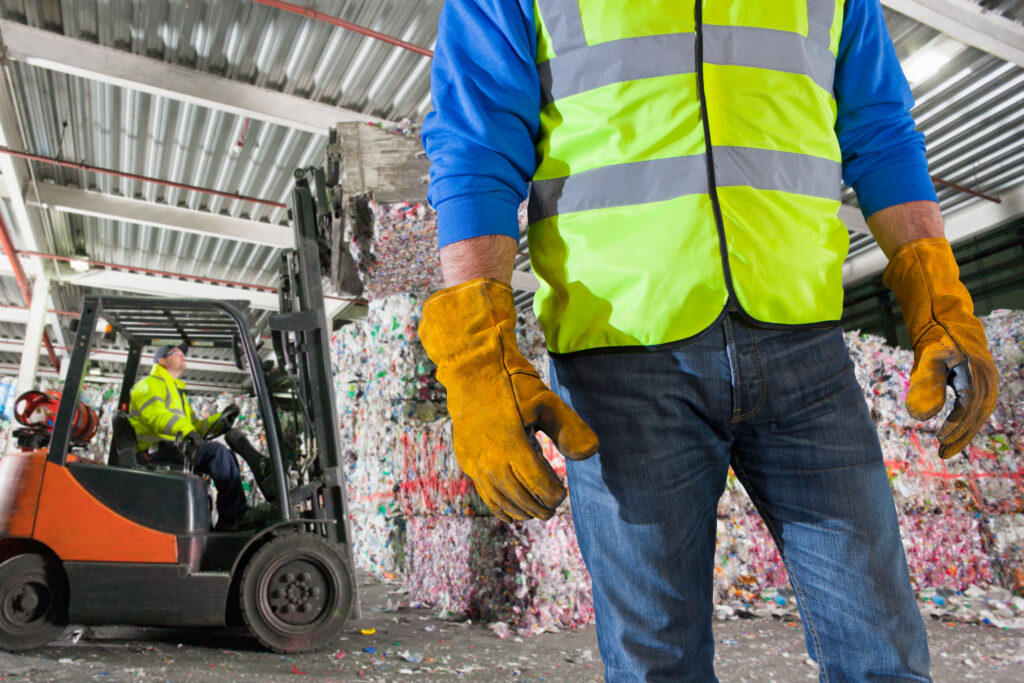Understanding Waste Management: Definition, Environmental Impact, and Strategies
Share:
Welcome to Thomas Insights — every day, we publish the latest news and analysis to keep our readers up to date on what’s happening in industry. Sign up here to get the day’s top stories delivered straight to your inbox.

Every year, more than two billion tons of municipal solid waste (MSW) are generated globally, of which 33% is not managed using environmentally safe processes. Due to rapid population growth and urbanization, this figure is expected to reach 3.4 billion tons within the next 30 years.
What is waste management, and how can comprehensive strategies mitigate the world’s waste problem?
What Is Waste Management?
The four major waste types are MSW, industrial waste, agricultural waste, and hazardous waste. Waste management refers to the streamlined processes used to safely manage and dispose of them, which include recycling, reusing, composting, and incinerating.
Increasingly, waste management practices are focused on driving sustainability, and the decisions of government bodies and waste disposal organizations are being guided by the waste hierarchy.
The waste hierarchy is a tool that evaluates and ranks waste management methods according to what is most environmentally friendly. The pyramid framework ranks “prevention” as the most favorable option, followed by reuse, recycle, recovery, and disposal.
Environmental Impact of Improper Waste Management
Improper waste management strategies wreak havoc on human health and livelihoods.
In developing countries, more than 90% of waste is openly dumped or burned. As a result, the poorest and most vulnerable people in society are disproportionately impacted by air and water pollution, land degradation, and economic decline.
Waste materials are also a major contributor to global warming. In the United States, MSW landfills are the third-biggest source of human-related methane emissions, comprising 14.3% of these emissions in 2021. A greener waste stream could reduce energy usage, preserve natural resources, and reduce carbon emissions.
The Role of Waste Management in the Supply Chain
Waste is generated at every stage of the supply chain, from the point when raw materials are extracted to when the end customer receives a finished product.
There are compelling reasons for organizations to better manage waste, whether they invest in reuse and recycling schemes, streamline their processes to reduce waste, or reduce their use of specific materials, such as plastic packaging.
For one thing, waste minimization drives cost savings and operational efficiencies. When less waste is produced, organizations spend less time collecting, sorting, and disposing. Further, with resources being scarce — and increasingly expensive — it’s important that no usable materials are discarded.
For another thing, effective waste management processes also improve brand reputation, which may result in a larger — and more loyal — customer base and more strategic partnerships with like-minded clients and suppliers.
Finally, governments around the world are setting recovery and recycling targets and developing regulations that pertain to waste management. Organizations that fail to comply may face sanctions and higher taxes.
Waste Management Strategies
Some of the most common waste management strategies include:
- Waste Prevention and Waste Minimization — These are the foundations of any effective waste management system. Various technologies and methods can be deployed throughout the manufacturing and distribution processes to eliminate waste and minimize pollution. An original equipment manufacturer (OEM), for example, might choose to work only with sustainable materials that do not cause toxic by-products when processed.
- Reuse — Products or components, that may otherwise have been discarded, are recovered and used for the same purpose and in their current form. For example, a manufacturer might collect material scraps or faulty components from a production line and reprocess them. This preserves the energy used to acquire or make them in the first place.
- Recycling — This disposal method sees waste materials, including paper, plastics, glass, aluminum, steel, and wood, are reprocessed into new products, materials, or substances. This prevents additional waste from being sent to landfills.
- Composting — Through decomposition, organic materials are converted into nutrient-rich soil, reducing landfill waste and carbon emissions.
- Waste-to-Energy — Waste-to-energy plants convert non-hazardous MSW into usable heat, electricity, and fuel. Conversion methods include incineration, gasification, or pyrolysis. While these processes can significantly reduce GHG emissions and reduce demand for fossil fuels, they can contaminate air, water, and land with toxic pollutants.
- Landfills — This waste disposal method is employed when waste materials cannot be processed via another — more favorable — method. Though there have been rapid advancements in the waste management industry, the vast majority of waste still ends up in landfills. Each year, U.S. landfills acquire 139.6 million tons of waste, which includes 30.63 million tons of food and 26.82 million tons of plastic.
Waste Management Infrastructure

Image courtesy of The Toidi / Shutterstock.com
Proper infrastructure is critical to a successful waste management system. It comprises waste collection and transportation services; sorting, treatment, and recycling facilities; and composting centers, waste-to-energy plants, and disposal units.
Investments in waste management infrastructure can reduce plastic waste, prevent hazardous materials from contaminating water streams, reduce GHG emissions, and divert usable materials away from landfills.
In Sweden, for example, the government has implemented a system that encourages waste-to-energy conversion and recycling. Today it recycles around 99% of its household waste and just 1% ends up in landfills.
In Singapore, organizations are entirely responsible for their waste and how they dispose of it. As a result, the country has just one landfill.
In Switzerland, it is compulsory to recycle and failure to do so will result in fines. Fortunately, the country has made it easy to do so; in Zürich alone, there are around 12,000 different recycling points.
Technological Innovations in Waste Management

Image courtesy of Blue Planet Studio / Shutterstock.com
The past couple of decades have given rise to numerous technologies capable of transforming the waste management industry.
A smart waste management plan is one that leverages technology — often powered by the Internet of Things (IoT) or artificial intelligence (AI) — to make waste collection and waste disposal more efficient and cost-effective.
Smart bins, for example, leverage IoT sensors to monitor when a unit is full and AI to sort recyclables from non-recyclables. Technologies like these drive major efficiencies throughout the waste management lifecycle since waste disposal companies can schedule their collection services based on when a bin needs to be emptied.
There are also solar-powered trash compactors that compress trash to increase bin capacity, countless recycling apps that educate the public about waste management, AI-powered recycling robots, machines designed for segregating waste, and e-waste kiosks that properly dispose of electronic devices.
Some cities are installing pneumatic waste disposal bins, which are connected to underground pipes. Solid wastes travel directly from the bins to a waste disposal unit, negating the need for collection and transportation services.
Waste Management Regulations and Compliance
The United States has implemented various regulations to ensure the safe and proper disposal of waste materials.
The Environmental Protection Agency, for example, regulates household, industrial, and manufacturing solid and hazardous wastes under the Resource Conservation and Recovery Act (RCRA).
The Solid Waste Program, which is under RCRA Subtitle D, motivates states to develop wide-ranging plans to manage nonhazardous industrial solid waste and municipal solid waste, establishes criteria for MSW landfills and other solid waste disposal facilities, and bans the open dumping of solid waste.
Regulations for hazardous waste also vary state-to-state. In Washington for example, organizations that use hazardous products or generate dangerous waste may be required to:
- Submit a Notification of Dangerous Waste Activities.
- Submit a Dangerous Waste Annual Report.
- Submit a Pollution Prevention (P2) plan.
The Biden Administration’s Bipartisan Infrastructure Law is also funding the development of three new EPA waste prevention, reuse, and recycling programs. These waste management deals include:
- Solid Waste Infrastructure for Recycling Grant Program, which provides grants to implement the National Recycling Strategy.
- Recycling Education and Outreach Grant Program will fund projects relating to education and recycling.
- Battery Collection Best Practices and Voluntary Battery Labeling Guidelines will develop battery recycling best practices and battery labeling guidelines.
4 Benefits of Effective Waste Management
Some of the benefits of effective waste management include:
1. Reducing the Burden on Waste Management Infrastructure
The best waste management systems will reduce waste generation, thus relieving the pressure on overstretched waste-processing facilities.
2. Resource Conservation
Reusing, recycling, and converting waste materials reduces dependence on non-renewable resources, like fossil fuels. In addition, diverting waste away from landfills improves economic efficiency.
3. Improved Brand Reputation
The EPA publishes a Major Criminal Cases report that reveals how some companies and individuals have broken environmental laws. It has previously called out major companies for violating federal and local waste management standards. Far better for organizations to be celebrated for their commitment to sustainable business practices.
4. Contributing to the Circular Economy
It is not possible to build a circular economy — i.e. an economic system based on the reuse and regeneration of materials and products — without establishing a circular waste management system. Waste management methods that focus on prevention, reuse, and recycling ensure that waste materials bound for landfills re-enter the economy.
4 Challenges and Future Trends in Waste Management
Some of the challenges of waste management include:
1. Lack of Landfill Space
Opinions differ on when, if at all, the world will run out of landfill space. Perhaps in 20, 50, or 1,000 years.
What is certain is that it is becoming much more difficult for the United States to send its landfill waste overseas. China, and several other countries, now impose strict controls on waste shipments. Before 2018, China processed half of the world‘s exports of plastic, paper, and metal waste.
2. Growing Electronic-Waste (E-Waste) Generation
In 2019, 53.6 million metric tons of e-waste were generated across the globe, with China, the United States, and India being responsible for the most toxic e-waste.
Most electronic devices are not biodegradable and will not break down naturally or safely in landfills. This leads to major environmental problems due to toxic chemicals, including lead, mercury, and arsenic, contaminating soil and water.
3. No Extended Producer Responsibility (EPR)
EPR is an environmental policy that would extend a manufacturer's responsibility for their product to the post-consumer stage of its lifecycle. Placing the financial burden of waste management onto the producers themselves would incentivize more rigorous and — crucially — more sustainable waste management methods.
4. Lack of Waste Management Infrastructure
Proper waste disposal methods are critical. However, at present, many nations lack the funding, technology, and resources to implement a comprehensive, end-to-end waste management system. With competing priorities, governments need to make difficult decisions about infrastructure in general.
The Future of Waste Management

Image courtesy of Virrage Images / Shutterstock.com
The urgent need for comprehensive waste management processes has long been important for governments, organizations, and the general public to remedy. In fact, waste-related carbon emissions are projected to increase to 2.6 billion metric tons by 2050.
The U.S. MSW industry is expected to generate $25 billion in revenue by the end of 2024. Much of this projected market growth can be attributed to investments in integrated solid waste management infrastructure, be it new treatment technologies, recycling centers, or waste-to-energy plants.
In addition, the World Bank has committed around $4.7 billion to more than 340 MSW management programs across the globe since 2000. Each new waste management plan brings the world closer to an optimized industry, one that prioritizes waste reduction, conserves natural resources, limits food waste, and effectively and efficiently processes recyclable waste.
Get More Waste Management Insights
- High-Tech Bins That Suck Waste Underground Could Mean the End of Garbage Trucks
- The Proper Steps for Waste Management Planning
- Top 5 Waste Management Services







